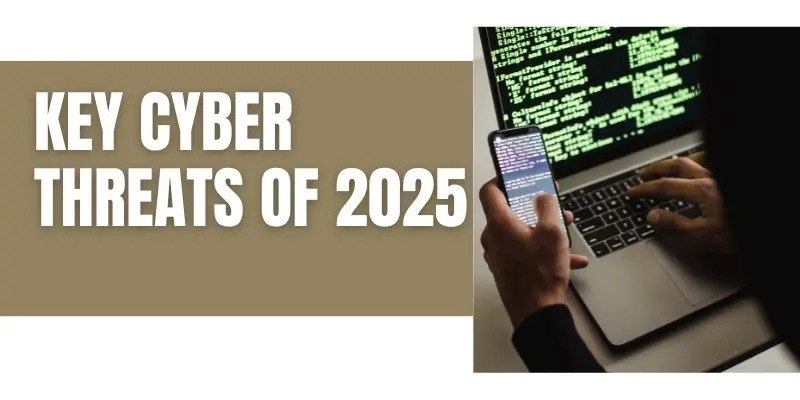Common Cyber Threats in 2025 and How to Stay Safe – Protect Yourself Now
Published: 07 Sep 2025
Cyber threats in 2025 are smarter, faster, and harder to detect. Attackers now use AI, advanced ransomware, and hidden backdoors to strike where we least expect. No one is safe—businesses, governments, even everyday users are targets.But here’s the truth: most attacks succeed because people don’t see them coming. Knowing what’s out there is the first step to staying safe.
In this article, we’ll uncover the most common cyber threats of 2025 and give you simple, practical ways to defend yourself. Stay alert,what you read here could save you from the next big attack.
Key Cyber Threats of 2025
The cyber world is changing fast.

In 2025, hackers are utilizing more sophisticated tools and devising innovative methods to breach systems. Below are the most common threats you should know about.
A. AI-Enhanced Threats
Artificial Intelligence (AI) is not only helping businesses—it is also helping hackers.
- AI-driven phishing and social engineering: Cybercriminals now use deepfake voices and fake videos to trick people. Imagine getting a call from what sounds like your boss, asking for an urgent money transfer. It looks and sounds real, but it’s a scam created by AI.
- Generative AI-based attack tools: Hackers use AI programs to create malware, fake emails, and even automated attacks in seconds. These tools can copy real writing styles, making fake emails very hard to detect.
AI makes attacks faster, more personal, and more believable.
B. Ransomware and Double Extortion
Ransomware is still one of the biggest threats in 2025. It locks files and demands payment. But now, attackers go further.
- Double extortion: Hackers don’t just lock your data—they also steal it. If you don’t pay, they threaten to leak private information online.
- Critical targets: Hospitals, banks, and even power companies are top targets. These services cannot afford to stop, so they often feel forced to pay.
Case Example: In a recent attack on National Defense Corporation, hackers stole 4.2 TB of sensitive data before locking systems. They demanded millions in ransom. This shows how serious ransomware has become.
C. Non-Human Identity (NHI) Threats & Supply-Chain Risks
Not all threats come through people. Many come from machines, apps, and devices that talk to each other.
- Non-Human Identities (NHI): Think of smart devices, IoT gadgets, and APIs that have special access to data. If hackers break into these, they can control systems without anyone noticing.
- Supply-chain risks: Hackers often attack through third-party services. For example, a weak vendor or software update can open the door for criminals to reach bigger companies.
This makes it important to not only secure your own system but also check the security of partners and suppliers.
D. Cloud-Native & Zero Trust Limitations
Most businesses are moving to the cloud, but that brings new challenges.
- Cloud complexity: Modern cloud systems use many tools like microservices and serverless functions. Traditional Zero Trust models often cannot keep up with this complexity.
- AI-driven extensions: To fill the gap, companies are now using smarter security like XDR (Extended Detection and Response), decentralized identity, and adaptive trust. These methods use AI to quickly detect and block threats.
The lesson: Zero Trust is no longer enough on its own in 2025.
E. Zero-Day, Misconfigurations & DDoS Attacks
Some of the oldest threats are still dangerous today.
- Zero-Day Attacks: These are attacks on new software flaws before the company can fix them. Hackers strike first, and defenses come later.
- Misconfigurations: Simple mistakes, like leaving a cloud storage open to the public, can expose millions of records.
- DDoS Attacks: Hackers flood websites with fake traffic until they crash. In 2025, DDoS attacks are bigger and more powerful, knocking services offline for hours.
Even one mistake can give hackers the opening they need.
These are the biggest cyber threats of 2025. They are advanced, fast, and often hard to spot—but not impossible to fight.
Emerging Threat Vectors & Statistics
Cyber threats are not only growing—they are changing shape. In 2025, new entry points are opening for attackers, and the numbers show why businesses and people need to stay alert.
A. Cloud-Related Threats
The cloud makes work faster and easier, but it also attracts hackers.
- A recent report shows that 42% of cybersecurity leaders see cloud attacks as their top concern.
- The risk comes from weak settings, poor access controls, and gaps between different cloud tools.
- Hackers often use hack-and-leak attacks, where they break into a cloud system, steal data, and then publish it online if no ransom is paid.
Even big companies that invest millions in security have suffered data leaks due to cloud misconfigurations.
B. Third-Party & Supply Chain Breaches
No company works alone. Businesses use software vendors, IT services, and cloud partners. But every third-party connection is a new doorway for hackers.
- Cybercriminals often attack smaller vendors because they are easier to breach.
- Once inside, they move to bigger targets connected to those vendors.
- Famous attacks in recent years show how a single weak link in the supply chain can cause global damage.
This is why companies now demand strict security checks from all partners.
C. Connected Product Attacks
From smart TVs to medical devices, everything is connected to the internet today. But every smart device can also be hacked.
- Attackers can take control of IoT devices, turning them into entry points.
- Once inside, they can move deeper into networks, sometimes reaching sensitive company data.
- In 2025, connected products are one of the fastest-growing risk areas because most of them don’t have strong built-in security.
D. The Human Factor
Technology may be strong, but people are often the weakest link.
- Studies show that 90% of all cyberattacks target employees.
- Hackers send fake emails, links, or calls to trick people into giving away passwords or clicking harmful links.
- On average, a company faces over 700 social engineering attempts every year. That’s almost two attacks every single day.
No matter how advanced security tools become, one careless click by an employee can open the door to an attack.
The numbers don’t lie: the cloud, third-party systems, connected devices, and even human behavior are now the main paths for cyberattacks in 2025.
Strategies to Stay Safe in 2025
Cyber threats in 2025 may look advanced, but smart defense steps can keep you safe. Here are simple, proven strategies for each type of threat.
A. Staying Safe Against AI Threats
Hackers now use Artificial Intelligence to trick people and create fast attacks. To fight back:
- Use AI-powered detection tools: These tools can spot suspicious patterns that humans may miss.
- Run simulation tests: Companies should practice fake attack drills, like phishing simulations, to train employees.
- Awareness training: Teach staff how to recognize deepfake voices, fake videos, and AI-generated emails. A trained employee is the best firewall.
B. Ransomware Defense
Ransomware can lock up systems and steal data, but strong preparation reduces the damage.
- Solid backup strategies: Keep offline and secure backups so data can be restored without paying ransom.
- Incident response planning: Every company should have a clear step-by-step plan for what to do if attacked.
- Vendor vetting: Ensure third-party vendors also follow strong security, since hackers may use them to enter.
With planning, ransomware becomes an inconvenience—not a disaster.
C. Securing Non-Human Identities (NHIs)
Devices, apps, and bots often have special access. If left unprotected, they become easy targets.
- Centralized NHI management: Keep track of all devices and apps that connect to your systems.
- Continuous monitoring: Watch for unusual activity, like a bot trying to access sensitive files at odd hours.
- Least privilege access: Give machines and apps only the permissions they need—nothing more.
This reduces the risk of silent attacks through hidden doors.
D. Advanced Cloud Security
Cloud systems are complex, but they can be made safer with the right tools.
- Adaptive trust models: Instead of always trusting devices, check their behavior every time they connect.
- XDR (Extended Detection and Response): Combines data from multiple sources to detect threats faster.
- Confidential computing: Protects data while it is being processed, not just stored.
- Decentralized identity: Gives users more secure, unique IDs that are harder for hackers to fake.
These steps make cloud systems much harder to break into.
E. General Best Practices
No matter the type of threat, some habits always help:
- Patch management: Keep software and systems updated so hackers can’t use old flaws.
- Risk assessments: Regularly review your systems to spot weak areas before attackers do.
- Phishing drills: Test employees with safe, fake phishing emails to build awareness.
- Threat intelligence: Use security reports and tools to learn about new attack trends before they hit.
With these strategies, individuals and companies can reduce risk and stay one step ahead of hackers in 2025. The key is awareness, preparation, and the right use of technology.
Real-World Examples
Cyber threats sound scary in theory, but they become real when we look at actual attacks. In 2025, several big cases showed how quickly hackers can cause damage—and how strong defenses can make a difference.
A. National Defense Corporation Ransomware Attack
One of the biggest incidents was the attack on the National Defense Corporation (NDC).
- Hackers broke into their systems and stole 4.2 terabytes of sensitive data.
- After stealing the files, they also locked important systems so staff could not work.
- They demanded millions in ransom, threatening to leak the stolen data online.
Lesson learned: NDC showed the world how dangerous double extortion ransomware has become. Having secure backups and a strong incident response plan is critical for surviving these kinds of attacks.
B. Healthcare Data Breach
Hospitals remain one of the favorite targets for cybercriminals. In early 2025, a large healthcare provider was hit by ransomware.
- Hackers disabled patient records and billing systems.
- Doctors and nurses were forced to use paper files for days, delaying care.
- Sensitive health records were stolen and later sold on the dark web. You can also use dark web monitoring tools for your security.
Lesson learned: Healthcare systems must encrypt patient data and run regular recovery drills to make sure critical services don’t stop during attacks.
C. Third-Party Vendor Supply Chain Attack
Another real example came from a global retailer. Hackers didn’t attack the company directly—they broke into a small third-party software vendor the company used.
- From there, they slipped into the retailer’s main systems.
- The attackers gained access to customer data, including emails and payment details.
- The breach caused major financial loss and damaged customer trust.
Lesson learned: Every company must check not only its own security but also the security of its vendors and partners. A weak link in the chain can open the door for attackers.
These real-world cases show that cyberattacks are not just technical problems—they affect people, businesses, and even national security. The good news is that each story also teaches us how to build stronger defenses for the future.
Future Outlook
The cyber world is not slowing down. In fact, the next few years may bring even bigger challenges. To stay safe, we need to look ahead and prepare for what’s coming.
A. The Rise of Quantum Computing
Quantum computers are powerful machines that can solve problems much faster than normal computers. While this is great for science and medicine, it also creates a huge risk.
- Current security systems like RSA encryption protect online banking, emails, and sensitive data.
- A strong quantum computer could break these protections in minutes.
- This means passwords, financial data, and even government secrets could be exposed.
The solution: Experts are now working on quantum-safe cryptography—new methods of encryption that can resist quantum attacks. Businesses should start preparing early by following updates from global security bodies.
B. Proactive Security Frameworks
Waiting for attacks to happen is no longer an option. Security must be proactive, not reactive.
- Organizations like ENISA (European Union Agency for Cybersecurity) have started publishing threat foresight frameworks.
- These frameworks help companies predict future risks instead of just reacting after the damage.
- By studying global threat trends, businesses can prepare stronger defenses in advance.
The solution: Adopt proactive frameworks and regularly update security strategies. Cybersecurity is no longer a one-time setup—it’s an ongoing process.
C. Smarter Attacks, Smarter Defense
Hackers will continue to use AI, automation, and advanced tools to create smarter attacks. But security experts will also use AI to build smarter defenses.
- Future defenses will focus on adaptive trust systems, where every user and device is checked in real time.
- Companies will rely more on threat intelligence sharing, where organizations exchange information about new attacks quickly.
- Governments and private companies will likely work closer together to stop large-scale cyber threats.
Conclusion
Cyber threats in 2025 are more advanced than ever, but they are not unstoppable. From AI-powered scams to ransomware and cloud attacks, hackers are finding new doors to break in. The good news is that awareness and preparation can close those doors. By using smarter tools, training people, securing partners, and planning for future risks like quantum computing, we can stay one step ahead. Cybersecurity is not just about technology—it’s about mindset. Stay alert, stay prepared, and you’ll stay safe in the digital world.
FAQs
The biggest cyber threats in 2025 include AI-powered attacks, ransomware, cloud breaches, and human errors. Hackers are using smarter tools to trick people. Businesses are also facing risks from third-party vendors. Staying alert and updated is the best defense.
Around 90% of cyberattacks start by targeting employees. Hackers use phishing emails, fake websites, or social tricks to steal data. Even one careless click can open the door to an attack. That’s why awareness training is very important.
Ransomware locks important files and asks for money to release them. This can stop a company’s work for days or weeks. Many businesses lose money and trust when this happens. Strong backup systems and quick response plans are the best shields.
AI helps hackers create more advanced scams and fake messages that look real. It can also be used to break into systems faster. However, AI can also fight back when used for detection and monitoring. It is a double-edged sword in cybersecurity.
Companies can use AI-powered tools for real-time attack detection. They should also run simulation tests to prepare employees. Awareness training helps staff recognize fake AI messages. Together, these steps reduce risks.
The best defense includes regular data backups, so files can be restored without paying hackers. Companies should also create an incident response plan. Checking vendors carefully reduces hidden risks. These steps save both money and time.
More companies store sensitive data in the cloud, making it a prime target for hackers. Weak passwords or misconfigured settings increase the danger. Cloud attacks can leak customer data quickly. Adaptive trust and strong monitoring make cloud use safer.
Quantum-safe cryptography is a new way of securing data from future quantum computers. These supercomputers could break today’s encryption easily. Preparing now keeps sensitive data safe in the long run. Many global organizations are already testing it.
ENISA and similar groups provide guidance on future cyber threats. They help countries and companies prepare before attacks happen. Their foresight reports highlight new risks and best defenses. Following them ensures better long-term safety.
Always use strong and unique passwords for each account. Update software regularly to fix security holes. Avoid clicking on unknown links or attachments. And, practice caution—think before you click.

- Be Respectful
- Stay Relevant
- Stay Positive
- True Feedback
- Encourage Discussion
- Avoid Spamming
- No Fake News
- Don't Copy-Paste
- No Personal Attacks

- Be Respectful
- Stay Relevant
- Stay Positive
- True Feedback
- Encourage Discussion
- Avoid Spamming
- No Fake News
- Don't Copy-Paste
- No Personal Attacks





